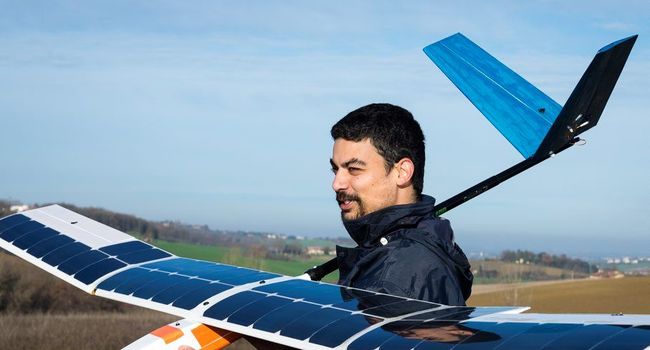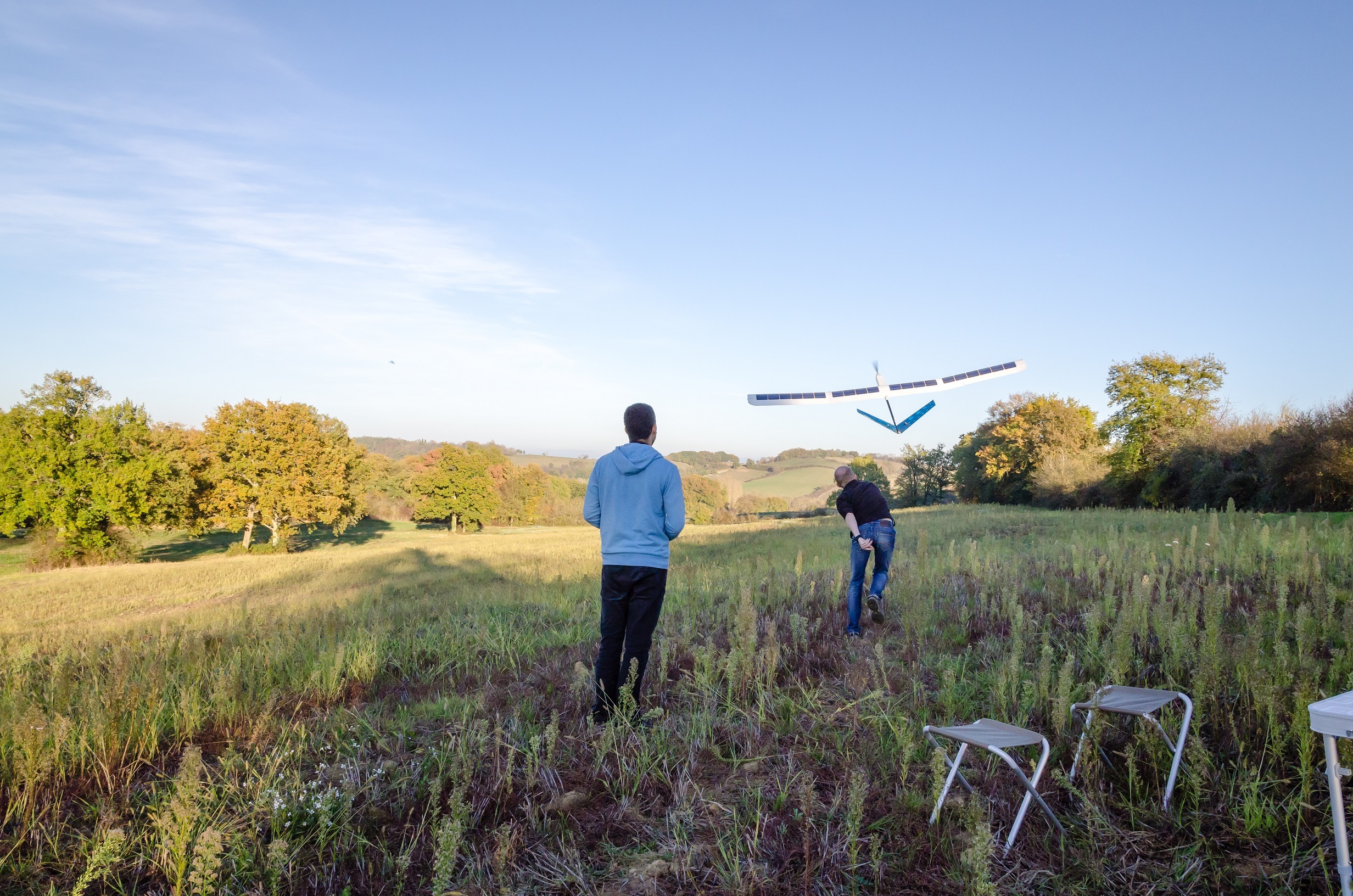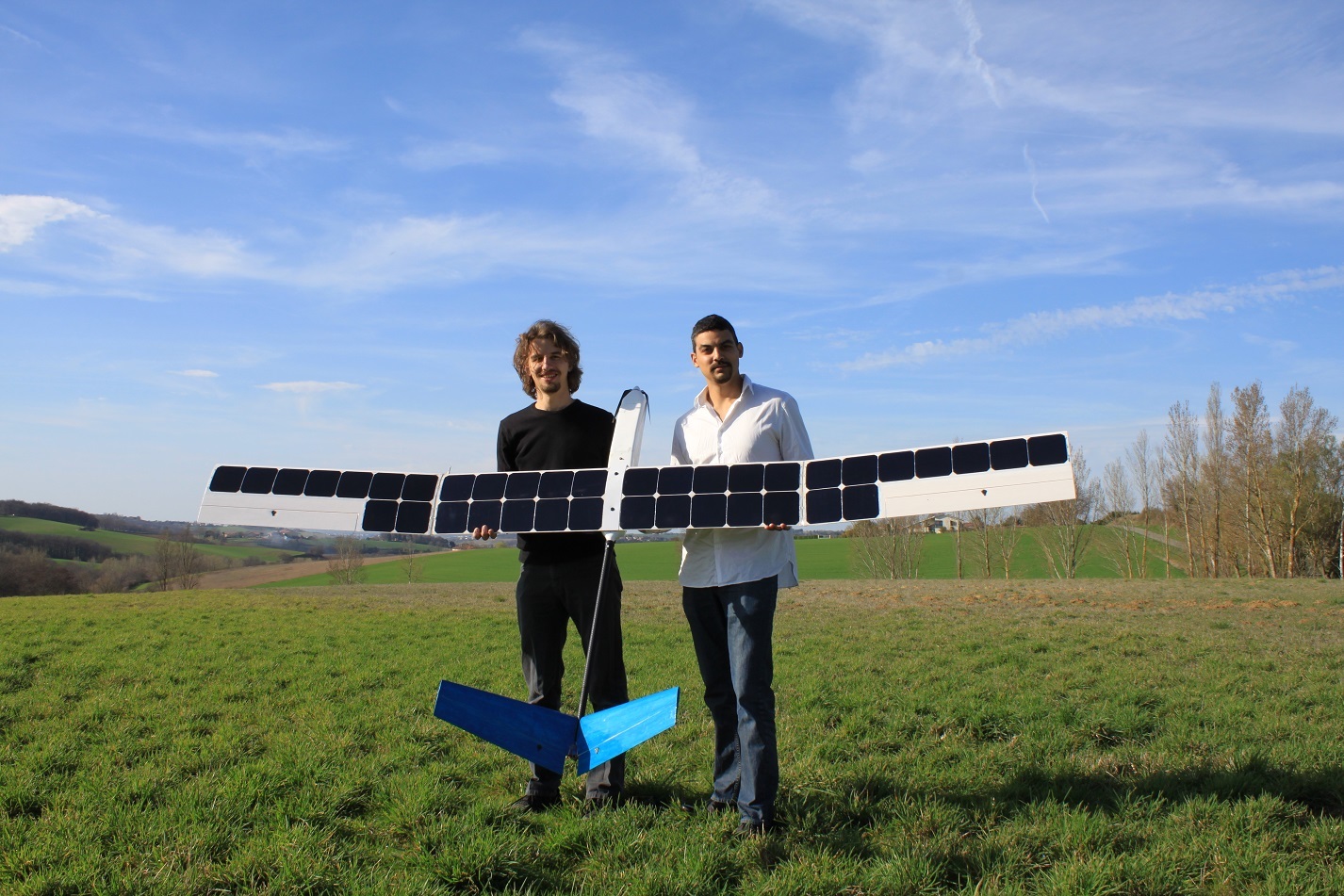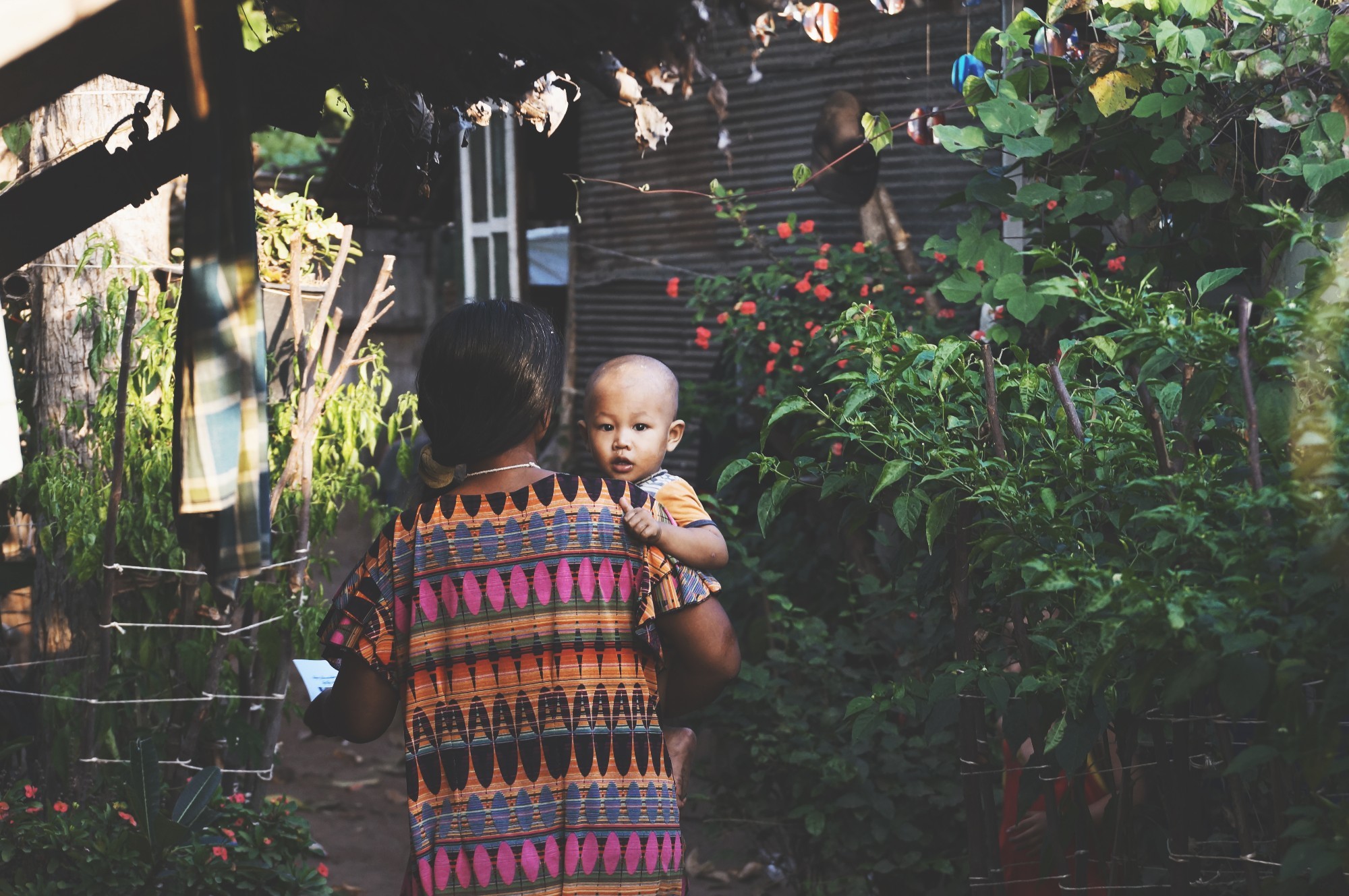In late February, the UN-Secretary General held a press conference, highlighting the risk of starvation in East Africa and the necessity to raise funds to address the emergency situations in Somalia and South Sudan. Drought has been back in these countries and their neighbours since 2016, leading to a huge current food crisis. While governments are trying to handle the situation, how could technology innovations help prevent starvation and improve agriculture management in the future?
We met with Laurent Rivière, a French 30 years-old entrepreneur, who shared with us his view on the subject with a combination of engineer pragmatism and changemaker idealism . Founder and CEO at Sunbirds for two years, he explained to us how his “bird of the sun,” his solar drone, is addressing the agriculture challenges of the 21st century.
In the Photo: SB4 Phoenix. Photo Credit: Sunbirds SAS
Laurent Rivière: I was working in research satellites, and was participating at the launch of satellite central softwares. I progressively became aware of the high potential of aerial observation and of creating a much smaller platform but also a more effective and low-priced one. This is where the idea of SB4 Phoenix was born: a UAV (commonly known as “drone”) using solar energy to fly all day long that was unique for its light weight (6.6 lbs) and its small wingspans (118.11 in). Also, the SB4 is fully autonomous except the take-off and the landing that are manual.
I started to build the first prototypes in 2013, in parallel to my job. The first models crashed so many times but I didn’t lose heart as I was seeing great potential with a lot of different applications. I kept going until 2015 when our prototype started flying for the first time. I then quit my job to dedicate my entire time to this project.
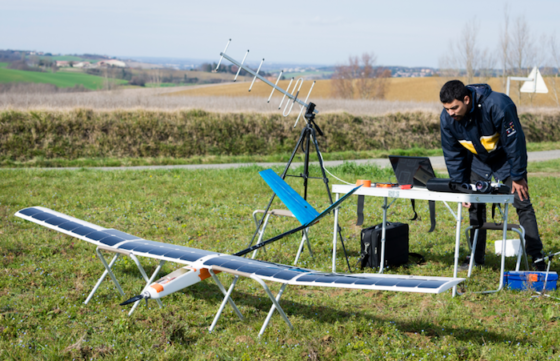
Also, I didn’t know anything about aviation when I started in 2013. I had to learn everything, it was very challenging but I loved it. Sunbirds is a story of passion and a technological challenge I wanted to take up.
In 2016, on a sunny September day in Toulouse, we were testing the SB4 and it flew for 6 hours! It was our own record but also a world one! We had finally created the first drone in the world that was able to fly indefinitely with solar energy.
In the Photo (RIGHT): Laurent Rivière preparing a flight. Photo Credit: Sunbirds SAS
How is a drone changing the way we approach agriculture, disaster response and security?
L.R.: Every day I discover a new potential application for the SB4. One of the most striking examples currently is the locust invasion in Madagascar. Did you know that more than 100,000 tons of crops are devastated every day? The swarm covers dozen of kilometers destructing all the crops and creating a high-risk of starvation. Currently, there are only planes and helicopters for the preventive maintenance but the island lacks resources to finance the fuel and the pesticides. By using our solution, they would not need a pilot, plane, or fuel. Our drone is able to map thousands of hectares and would identify immediately when new locust swarms are forming. Thereafter, instead of trying to destroy the swarm when it is already huge (up to 500 billion in 2014), we would be able to locate them early and to treat them more easily with pesticides. It can literally save a country from starvation.
What are all its other applications? Which one are you going to focus on?
L.R.: Sunbirds’ vision has evolved a lot since its beginnings. We are able to do incredible things thanks to our technology. We can address environmental and agricultural issues : insect crises (like the locust ones), detection of plant diseases that a satellite can’t do (such as fungus), mapping of thousands of forest hectares to protect endangered species, detection of water leaks in hectares of pipelines, and so many others.
With these applications we can then have a direct impact on development issues such as starvation and drought.
Also, we can tackle more social issues in a context of political crises or migration crises for example being able to map a displaced population and improve the management of migratory flows. Our solution concerns a whole range of countries : Africa, Brazil, Oceania, Middle-East … any country with high sun exposure!
Currently, we are focusing on agriculture and land use and sustainable management of resources. There is a global awareness on the necessity of managing the forestry concessions while ensuring the conservation of protected species’ habitat (we talk here about High Conservation Value – HVC – Zone). For example, Gabon’s president declared recently his wish to transform all of Gabon’s forests into HVC zones. It’s the right time but it’s also the best market for Sunbirds. First, in countries like Africa, our drone is able to fly all day long with the sun energy, and second our key qualities are monitoring and daytime mapping. It is then the perfect fit for agriculture and land use and sustainable management of resources.
What are the mechanics behind the drone’s applications?
L.R.: Our UAV uses solar cells on its wings to have enough power to maintain its flight level. When it’s cloudy or for take off we need more power and we use a battery, knowing that we designed our own solar power electronic modules capable of managing the solar cells and batteries. We also had to optimize aerodynamics of the plane in order to minimize the power consumption and to be able to maintain the flight level only by using solar cells. We are the only one on the market able to achieve this performance. Also, depending of the application we use a different kind of camera, RGB(Red Green Blue) camera for general mapping, infrared cameras for surveillance, allowing us to detect people or animals in the real time, multispectral cameras for agriculture and crops mapping. For example, a high radiation near infrared means a good health for vegetation, and a low radiation level means that the hydric stress is really high.
What makes your drones different from existing ones?
L.R: Our drones are the most enduring ones in the world: they are the only ones that can fly all day long and are so lightweight. Our main competitors are fixed-wing drones companies that benefit from a better visibility as they have the advantage of being on the market for a longer period, but they generally fly only one hour or two. We also have an American competitor which is a bit bigger and heavier, and is more focused on military surveillance.
For us, the military is a second target as we are able to monitor sensible areas or convoys in Africa for example. But we are convinced that our main potential remains first in agriculture and land use.
In the Photo: Laurent Rivière and his co-founder Laurent Moure launching the solar drone. Photo Credit: Sunbirds SAS
How does your technology prevent interference with commercial aircraft?
L.R.: In France we fly under the regulated airspace which is under 150 meters (5905 inches). There are other rules we have to respect as well. For example, the drone can’t fly “Beyond-Line-of-Sight” (BLOS), meaning it must not move away from the drone pilot more than 100 meters, except if its weight is under 2 kg (4,4 lb) or if you have a special exemption. However, rules are different in each country. In some African countries for example, you can fly “BLOS” (you launch the drone so far that you can’t see it anymore) as drone regulations haven’t yet been implemented and as there are still many unpopulated areas. That is part of the challenge: regulation around drones is not standardized and we have to get to know each market, no matter how different they can be from each other.
How will your product help to reach the Agenda 2030, and especially the SDGs (2, 7,9,15)?
L.R.: It is an innovative product using renewable energy to solve any issue regarding the sustainable management of resources and land while minimizing costs. As we map thousands of hectares thanks to solar energy to address conservation issues, we are directly progressing towards SDGs 7, 9 and 15 (cf. “Affordable and Clean Energy”, “Industry, Innovation and Infrastructure” and “Life on Land”). Also, our participation for example in the locust crisis program that the FAO has implemented would help all of us reach SDG 2 by limiting hunger and starvation.
Related Articles: “SDG 7: AFFORDABLE AND CLEAN ENERGY FOR ALL – YOUTH LIGHTING UP THE WORLD”
How do you run Sunbirds for now? Are you going to recruit?
L.R.: We are currently raising funds and starting the drone marketing abroad, in Africa and Brazil. I am focusing at the moment on business development while my three co-founders Stéphane, Marc and Laurent are respectively CTO, head of production and flights test and post-data processing manager. We are all experts in aeronautics and we have been now working together for four years. We gathered around this same additional passion for innovation and the startup ecosystem in general. We aim to have at least 10 members in the team after the fundraising and we plan to recruit different profiles such as business development in Africa, aeronautical engineers, sales representatives, developers, etcetera.
Since January we have integrated with an accelerator, the “IOT Valley”. We did flight missions for Enedis (ERDF power line inspections) and we are starting to get a great network of distributors, drones professionals, public and private institutions specialized in global development in Africa.
We are now essentially raising funds from business angels, more precisely 500K euros to be able to structure the production chain (50 units per year), to export abroad and to continue research and development. Several business angels are already committed and we started to sell the product in Brazil, South Africa and to international organizations specialized in sustainable agriculture.
In the Photo: Laurent Rivière and his co-founder Stephane Massot with the SB4. Photo Credit: Sunbirds SAS
What do you like the most about the daily life of an entrepreneur?
L.R.: Being able to create things that don’t exist to answer large-scale issues! What I find the most motivating is the idea that a technological challenge can serve as wide a range of countries as possible regarding development, social and environmental issues. On a daily basis I love developing a product and solving scientific issues while trying to embrace the issues of my international customer audience. I have initially a very technological profile and I never thought I would need one day to understand deeply the issues around sustainable development and agriculture. Learning everyday about other issues makes me more open-minded and able to see the greater potential behind my drone than the technology only.
For me this is the greatest thing about entrepreneurship : finding a problem, falling in love with it, getting to know everything about it in order to innovate and to create the best suitable solutions.
What are the main challenges you have encountered building your business?
L.R.: It didn’t work for three years. We had one crash after another. I have always been persistent (or stubborn you may say!) and I never doubted our product because I wanted it to work. I knew perfectly well after each failure why it didn’t work and how to get back on my feet again. It helped me a lot to progress.
I am completely convinced that failure is part of the innovation process and is essential for success.
The other main challenge was to learn everything by myself again, as I mentioned quickly before. I am an expert in embedded-system, software development and electronics. To create the SB4 I had to acquire strong skills as well in aerodynamics, flight mechanics, 3D modeling, image processing, and solar energy. Afterwards, to develop Sunbirds I have been working on my business development skills such as creating a marketing strategy or developing and exporting an innovative product abroad. I must admit, it’s a part I find ever more thrilling over time.
What are the next steps?
L.R.: We are aiming to expand Sunbirds internationally and to create a large distribution network. Our main objective today is to help countries solve issues regarding sustainable agriculture and resource management. Our aerial observation solution is disruptive in that we can observe huge spaces at a very low cost. It opens new doors to all actions regarding development in Africa, Latin America, Oceania, Southeast Asia, and the Middle-East. That’s why one of our main focuses is to develop partnerships with international organizations such as the FAO, IUCN, UNDP, World Bank, WWF and any other organizations or foundations working in development, especially in Africa.
My dream is to see one day that my solution can help on a daily basis the main actors of international development.
What advice do you recommend to an entrepreneur in the making?
L.R.: Don’t think too much, jump. Don’t listen to naysayers, spend instead a lot of time listening your customers and understanding their issues . Don’t try to solve thousands of problems, choose one that concerns lots of people, that is scalable. And of course, enjoy yourself!
To learn more about Sunbirds: http://sunbirds-uas.com/en/index.html
To contact Laurent Rivière: laurent.riviere@sunbirds-uas.com
Recommended Reading: “BEHIND THE LENS WITH MSP FILMS”


